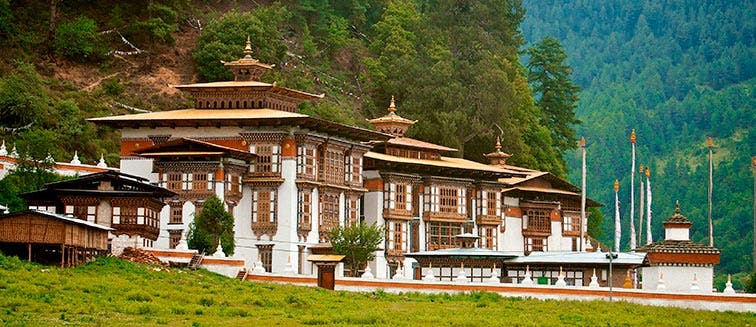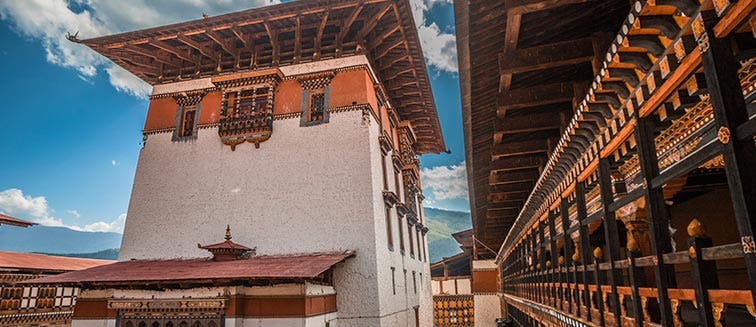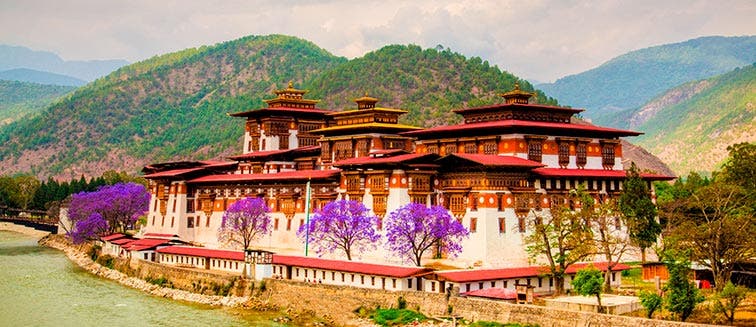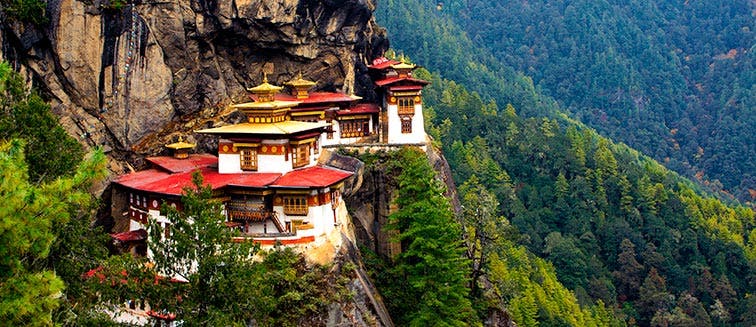Africa
Americas
Asia
Europe
Oceania
Holidays to Europe (93 available)
Albania(2)
Austria(6)
Baltic States(3)
Belgium(5)
Croatia(3)
Cyprus(1)
Czech Republic(5)
Denmark(1)
England(10)
Finland(2)
France(13)
Germany(7)
Greece(10)
Holland(5)
Hungary(4)
Iceland(6)
Ireland(9)
Italy(13)
Montenegro(1)
Northern Ireland(2)
Norway(9)
Portugal(9)
Romania(1)
Scotland(6)
Slovakia(1)
Spain(9)
Sweden(2)
Switzerland(4)
By Season
By Interest
By Group
What to see in Bhutan
Thimphu
Tourist attractions Thimphu
Thimphu is the third highest capital in the world at 2248 m above sea level. The capital of Bhutan since 1955, prior to this date the city was reduced to a fortress with several houses around. Today it is the seat of the royal family and the government and is the cultural and commercial capital of the country.Located in the northwest of Bhutan, on the banks of the Wang Chu River, it is home to approximately 12,0000 inhabitants among which some monks, merchants, executives and even the king himself have been trained in prestigious Anglo-Saxon centres, from which a small bourgeois population has been created in the city.Thimphu has an ordered urban layout and a careful traditional architectural image like most cities in Bhutan. There are very good houses and luxury cars abound around the streets. The dogs, peaceful, roam loose in the streets and take naps in the middle of the sidewalk. It is the only capital in the world that does not have traffic lights and it is the policemen dressed in blue uniforms and white gloves, who are in charge of regulating traffic with very comical movements of hands and arms.
The first dzong of Thimphu was built in 1216 on a hill to protect against Tibetan invasions, but being too small to house so many monks and civil servants, another known as the lower dzong was built. The previous one burned down in 1771 and the new one suffered damage caused by an earthquake in 1897, so it was completely renovated and expanded to the traditional Bhutanese way, without using nails or written architectural plans.The splendid Dzong Trasi Chhoe means "Fortress of the Glorious Religion". It has a beautiful and imposing whitewashed structure of two floors and three-story towers with three-level square roofs painted red and gold. Like all the fortresses of Bhutan, it consists of several buildings and is shared by monks and officials. It houses the office of the king, ministers and government organizations, the audience hall and the Buddhist monastery which is the summer residence of the Bhutan religious leader Je Khempo and about 300 monks, the most important monastic community in the country. The peasants take their children to the dzongs at the age of five or six years to bring their family great prestige and religious merits. At 5 o'clock in the afternoon, there is a flag drop in which the police and the monks participate and the time of the visits begins. The walls that surround the great patio are covered with decorative structures, balconies, pillars and columns of carved wood, painted with geometric patterns of colours. The interior stands out for its great delicacy and inside you can find bas-reliefs, sculptures of deities, symbolic and mystical decorations and paintings of cosmic mandalas.At dusk, when the first lights of the fortress begin to light up, its black silhouette fills with vibrant and small red flashes in the windows and the panorama becomes mysterious and magical.The Memorial Chorten is an important downtown monument that was built in 1974 and consists of a large white and gold stupa that was built in memory of the third king of Bhutan. Like all of them, it symbolizes the five elements and, unlike others, it does not contain human remains, but a photo of Druk Gyalpo adorns the ground floor room and houses sculptures and paintings of deities.It is one of the most visible religious structures of the capital and the place of daily prayer for a large part of the population. The faithful circle around clockwise as they spin the prayer wheels they hold in their hands and focus on their prayers.The current building of the National Library was inaugurated in 1984 and houses an incalculable collection of ancient books, religious manuscripts, traditional texts and microfilms.Nearby is the National Textile Museum that exhibits a wide variety of traditional costumes from all regions and kings, as well as the techniques of spinning traditional fabrics.A visit to the Zorig Chusum Institute, commonly called the School of Arts and Crafts, is very interesting. In the entrance courtyard, there is a sculpture that refers to the iconic image of the 4 harmonious friends, which promotes the didactic story of an elephant, a monkey, a rabbit and a bird that were concerned to help each other without being selfish and taking care of others. You can enter the classes and contemplate how children are taught in any of the thirteen traditional arts of Bhutan, such as painting on canvas, sculpture in clay, wood carving, drawing of mandalas or hand embroidery, among others. The pieces made by the students are sold at a very good price there.The spectacular statue of Buddha Dordenma can be seen from all parts of the city. Its golden silhouette is drawn small and far up on a hill, but when you get to arrive it impresses visitors with its huge dimension and its height. The millionaires of Singapore paid for this impressive work of gold-plated bronze, built in China for the occasion of the 60th birthday of the fourth king and was transported by truck to Thimphu to be mounted there. From above there are fantastic views of the entire valley and the capital. At its base there is a beautiful chapel home to 125,000 equal statuettes of Buddha that have been donated by the faithful.The Centenary Farmers Market is open at the weekend. Farmers come to sell their food such as fruits, vegetables, cheeses and sausages or legumes. It is incredibly clean and tidy.The Motithang Takin reserve is a natural space located in a pine forest that allows us to contemplate the takin, a strange animal that, according to legend, was formed from the halves of two others. This animal looks like a hybrid between a cow and a goat and is in danger of extinction. There are also Himalayan goats and deer.A popular activity in Thimpu is to attend the games of archery, the national sport. The archers shoot their arrows at a target that is hard to see due to their distance, demonstrating their skill and spectacular visual acuity.The Clock Square is the most central point and the busy Norzim Lam Street is full of shops selling handicrafts.Thimphu is the capital of the country, but it seems more like a big town and this is contributed to the absence of traffic lights, which makes it seem even more provincial. Based on the fact that all Bhutan localities respect traditional aesthetics and customs, in the streets of Thimphu, a modern attitude is perceived in response to recent changes that do not occur in others. The capital is bustling and has a young and pleasant atmosphere.
OUR BEST TRIPS TO THIMPHU
YOU ALSO LIKE
Bhutan
2 Trips
India
10 Trips
Maldives
5 Trips
Nepal
5 Trips
Saudi Arabia
2 Trips
Sri Lanka
5 Trips
United Arab Emirates
3 Trips
Turkey
8 Trips
Jordan
5 Trips
Israel
Notify me when available
Armenia
Notify me when available
Uzbekistan
2 Trips
Oman
Notify me when available
Lebanon
Notify me when available
Kazakhstan
1 Trips
Kyrgyzstan
Notify me when available
Qatar
4 Trips
Bahrein
1 Trips
Cambodia
4 Trips
Thailand
6 Trips
Vietnam
7 Trips
Myanmar
Notify me when available
Indonesia
9 Trips
Malaysia
2 Trips
Philippines
2 Trips
Singapore
2 Trips
Laos
Notify me when available
China
3 Trips
Japan
9 Trips
Hong Kong
1 Trips
South Korea
6 Trips
Tibet
Notify me when available
Mongolia
Notify me when available
Taiwan
Notify me when available
Tourist attractions bhutan
Points of interests
Other Points of interests
- Trips to Abhaneri
- Trips to Abu Dhabi
- Trips to Agra
- Trips to Al Hofuf
- Trips to Al Ula
- Trips to Al-Hasa
- Trips to Alleppey
- Trips to Amber Fort
- Trips to Amritsar
- Trips to Anuradhapura
- Trips to Arabian Desert
- Trips to Bandhavgarh National Park
- Trips to Beruwala
- Trips to Bikaner
- Trips to Chennai
- Trips to Chitwan
- Trips to Colombo
- Trips to Dambulla Caves
- Trips to Dammam
- Trips to Delhi
- Trips to Dhiffushi
- Trips to Dubai
- Trips to Ella
- Trips to Everest
- Trips to Fatehpur Sikri
- Trips to Fuerte de Agra
- Trips to Galle
- Trips to Goa
- Trips to Gulhi
- Trips to Guraidhoo
- Trips to Ha'il
- Trips to Hegra
- Trips to Huraa Island
- Trips to Jaipur
- Trips to Jaisalmer
- Trips to Janakpur
- Trips to Jantar Mantar
- Trips to Jeddah
- Trips to Jodhpur
- Trips to Jubbah
- Trips to Kajuraho
- Trips to Kandy
- Trips to Kanha National Park
- Trips to Kathmandu
- Trips to Kerala
- Trips to Kochi
- Trips to Koggala
- Trips to Lumbini
- Trips to Maafushi
- Trips to Madain Saleh
- Trips to Madinah
- Trips to Madurai
- Trips to Mahabalipuram
- Trips to Malé
- Trips to Mandawa
- Trips to Matale
- Trips to Nagarkot
- Trips to Negombo
- Trips to Nuwara Eliya
- Trips to Palacio de Jaipur
- Trips to Patan
- Trips to Pench National Park
- Trips to Periyar National Park
- Trips to Pinnawala
- Trips to Pokhara
- Trips to Pondicherry
- Trips to Rajasthan Desert
- Trips to Ranthambore
- Trips to Rishikesh
- Trips to Riyadh
- Trips to Seeduwa
- Trips to Sigiriya
- Trips to Tabuk
- Trips to Taj Mahal
- Trips to Thanjavur
- Trips to Udaipur
- Trips to Varanasi
- Trips to Welligama
- Trips to Yala National Park
Countries Nearby
- Armenia Trips
- Bahrein Trips
- Bhutan Trips
- Cambodia Trips
- China Trips
- Hong Kong Trips
- India Trips
- Indonesia Trips
- Israel Trips
- Japan Trips
- Jordan Trips
- Kazakhstan Trips
- Kyrgyzstan Trips
- Laos Trips
- Lebanon Trips
- Malaysia Trips
- Maldives Trips
- Mongolia Trips
- Myanmar Trips
- Nepal Trips
- Oman Trips
- Philippines Trips
- Qatar Trips
- Saudi Arabia Trips
- Singapore Trips
- South Korea Trips
- Sri Lanka Trips
- Taiwan Trips
- Thailand Trips
- Tibet Trips
- Turkey Trips
- United Arab Emirates Trips
- Uzbekistan Trips
- Vietnam Trips
Trip Styles
Susbscribe to our newsletter and join Exoticca GO
The best travel deals
Exclusive promotions
Expert travel tips



